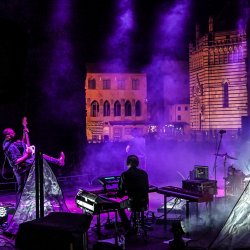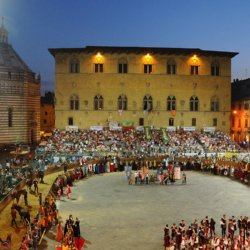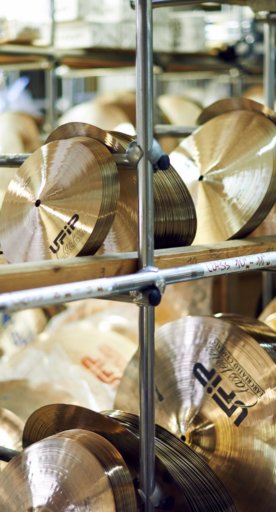

Pistoia, the Italian Santiago
Discovering the traditions associated with the cult of San Jacopo
Pistoia is strongly linked to the cult of San Jacopo (also known as Saint James the Greater), an ancient tradition reflected in the city's tangible and intangible heritage.
Whenever July 25, the day dedicated to the saint, falls on a Sunday, the Jacobean Year is celebrated, a religious and spiritual event full of celebrations that make it a unique opportunity to discover this fascinating Tuscan town.
-
1.The cult of San Jacopo
-
2.July in Pistoia
-
3.Crossroads of paths
The cult of San Jacopo

The city has been linked to the cult of the Apostle James the Greater since 1145, the year in which Bishop Atto had a fragment of the saint's skull arrive from Santiago de Compostela. The relic is kept in the Cappella del Giudizio (Chapel of the Judgment) in the Cathedral of San Zeno, in a splendid gold and silver reliquary made in 1407 by Lorenzo Ghiberti.
In the same chapel is another masterpiece of high jewellery: the Altare Argenteo (Silver Altar). Made over the course of two centuries, starting with the original core of the altar, a 1287 silver panel representing the Twelve Apostles, it is the result of the work of the many goldsmiths who took turns in creating the panels.
In the 15th century, a young Filippo Brunelleschi, employed in the workshop of Lunardo di Mazzeo and Piero di Giovanni da Pistoia, also contributed to the work sculpting, according to tradition, the busts of the prophets Jeremiah and Isaiah, St. Augustine and St. John the Evangelist.
July in Pistoia

The culture, heir to a long tradition that saw Pistoia as a crossroads of paths between Rome and Santiago, has remained alive over the centuries, and attesting to this are places of worship and traditions in Pistoia, especially those related to the Jacobean festivities, such as the Vestizione di San Jacopo (Dressing of Saint Jacob), during which the statue of the saint, placed on the roof of the Cathedral of San Zeno, is "dressed" in a blessed red cloak.
The event precedes the religious ceremonies on July 25, the Historical Procession and the Holy Mass, and the Giostra dell’Orso (Joust of the Bear), an equestrian palio documented since the first half of the 13th century.
Crossroads of paths

In the Middle Ages many pilgrims, on their way to Santiago de Compostela or Rome, stopped in Pistoia, taking the opportunity to pay homage to the Apostle's relic. By virtue of this deep and widespread cult, Pistoia was named the Santiago Minor (Little Santiago).
A further affinity with the Galician city is the nine-rayed shell, an emblem of pilgrimage and a thread that can be found on many monuments in the historic town center of Pistoia. In addition, the shell is a symbol of the Cammino di San Jacopo (Saint Jacob’s Trail), a new track connecting Florence to Livorno.
And as of 2019, Piazza del Duomo is home to the only Italian stone on the Camino de Santiago, indicating the distance to the Spanish town.


















































